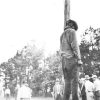calsfoundation@cals.org
Peter Berryman (Lynching of)
On February 20, 1901, Peter Berryman (regularly referred to as “Nigger Pete” in newspaper articles) was lynched in Mena (Polk County) for the alleged assault of young Essie Osborne. Berryman’s murder and numerous other instances of racially motivated harassment throughout the years in Mena—combined with changing job prospects with the relocation of railroad division shops—likely played a role in convincing many African Americans to leave the area, and Mena slowly became a “sundown town.” There were 152 black residents of Mena in 1900 but only sixteen in 1910.
In 1900, Peter Berryman, age forty-five, was living alone in a house in Mena. He could neither read nor write; his occupation is illegible on the census record. According to various newspaper accounts, Berryman was “half-witted” and had committed several crimes in Mena, including a near-fatal attack on an engineer with an axe. In October 1899, he had an argument with a deputy marshal because he was cooking meals in the alley behind Garrett’s Saloon. The marshal attempted to arrest him, resulting in a fight during which the marshal hit Berryman several times over the head with his billy club. Berryman appeared in court the following morning and was fined. In general, however, the citizens of Mena seemed to tolerate his erratic behavior.
On February 19, 1901, Berryman allegedly attacked Essie Osborne. Essie’s mother, hotelkeeper Almira Osborne, told the Arkansas Gazette that Berryman was accustomed to coming into the family’s yard for water through an opening in their fence, but he had recently argued with the Osborne children. Essie was sent out to board up the opening, and when Berryman encountered her, he began to tear the boards off. She threatened him with a hammer, and he kicked her in the abdomen, injuring her severely. Berryman was arrested and jailed pending trial the following day.
In the middle of the night on February 20, Officer Al Jones was making his rounds when he was accosted by a group of masked men. According to the Salt Lake Herald, the men “met Night Officer Jones and compelled him at the point of guns to hand over the keys and his revolver. Two of them were left to guard Jones, while the others went to the jail and secured the negro. About 2 o’clock they returned where the officer was being guarded and gave him his keys and gun. Then the men quietly disappeared without a word.”
Jones woke up other men and began to search for Berryman. The St. Louis Republic reported that Berryman’s body was found at daylight, hanging from a tree outside of town, “gruesomely beaten, bloody, and shot.” According to the journal of Ormond H. Twiford, quoted by Walter Brown, Berryman’s body was left at the foot of the tree so that area residents could view it. The Mena Star reported that “hundreds of curious citizens” did so.
A coroner’s jury was called, and prosecuting attorney James Steele opened an investigation into Berryman’s death. Residents of Mena were reportedly outraged. According to the Star, “Stating it very mildly and dispassionately we will say that every good citizen of this community deplores the unlawful and disgraceful occurrence in this city last night.” The editor blamed the state for failing to provide somewhere “to confine such characters as ‘Crazy Pete’ who stands as a menace to public safety.” The Business Men’s Club, meeting on the evening of February 20, condemned Berryman’s murder as “brutal and uncivilized” and expressed deep regret “that such an act of brutality should have been perpetrated in our city.” At a public meeting held at the county courthouse, $380 was raised as a reward for the arrest and conviction of Berryman’s murderers (this was later increased to $400). Attendees also asked Governor Jeff Davis to match the amount, as required by Arkansas law. Davis declined, saying that there was no more money left in the budget for such a purpose. In the end, no one was ever apprehended for Berryman’s murder.
For additional information:
“At Dead of Night.” Mena Star, February 21, 1901, p. 1.
“Big Reward Offered.” Mena Star, February 25, 1901, p. 5
Brown, Walter L., ed. “Life of an Arkansas Logger in 1901.” Arkansas Historical Quarterly 21 (Spring 1962): 44–74.
Coogan, Harold. “The Lynching of Peter Berryman, February 20, 1901.” The Looking Glass 19 (Fall 1993): 6–9.
“A Disgraceful Crime.” Mena Star, February 20, 1901, p. 2.
“Hanged to a Tree.” Mena Star, February 20, 1901, p. 5.
Lancaster, Guy. “‘There Are Not Many Negroes Here’: African Americans in Polk County, Arkansas, 1896–1937.” Arkansas Historical Quarterly 70 (Winter 2011): 429–449.
“Lynch Law Denounced.” Mena Star, February 21, 1901, p. 3.
“Mob of Eight Men Lynches a Negro in an Arkansas Town.” Salt Lake Herald, February 21, 1901, p. 1.
“Mobs in Three States Try to Take Law in Their Own Hands: Negro Lynched at Mena, Ark.” St. Louis Republic, February 21, 1901, p. 1.
“‘Nigger Pete’ in Trouble.” Mena Star, October 10, 1899, p. 3.
“No State Funds for Rewards.” Mena Star, March 1, 1901, p. 3.
“Rope Route.” Arkansas Gazette, February 21, 1901, p. 1.
Nancy Snell Griffith
Clinton, South Carolina
 Brown, Walter Lee
Brown, Walter Lee Civil Rights and Social Change
Civil Rights and Social Change Early Twentieth Century, 1901 through 1940
Early Twentieth Century, 1901 through 1940 Lynching
Lynching Mena Lynching
Mena Lynching 




Comments
No comments on this entry yet.